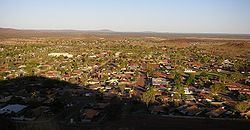Population 5,478 (2011 census) Postcode(s) 6753 Mean max temp Mean min temp Postal code 6753 Number of airports 1 | Established 1960s Elevation 544 m Local time Sunday 5:23 PM | |
 | ||
Location 1,189 km (739 mi) N of Perth452 km (281 mi) S of Port Hedland404 km (251 mi) N of Meekatharra 277 km (172 mi) SE of Tom Price Weather 30°C, Wind SE at 6 km/h, 57% Humidity | ||
Newman, originally named Mount Newman until 1981, is a town in the Pilbara region of Western Australia. It is located about 1,186 kilometres (737 mi) north of Perth, and 9 kilometres (5.6 mi) north of the Tropic of Capricorn. It can be reached by the Great Northern Highway. In the 2011 Australian census, its population was 5,478. Newman is a modern mining town, with homes contrasting with the surrounding reddish desert.
Contents
Map of Newman WA 6753, Australia
The Hickman Crater is 35 kilometres (22 mi) north of Newman.
History
Newman was established as Mount Newman by Mt. Newman Mining Co. Pty Ltd (a subsidiary of BHP) in 1966 as a company town to support the development of iron ore deposits at nearby Mount Whaleback. The town takes its name from nearby Mount Newman, named in honour of government surveyor Aubrey Woodward Newman, who died of typhoid at Cue on 24 May 1896, while on an expedition from Nannine to the Ophthalmia Range. William Frederick Rudall then took charge of the expedition and named Mount Newman to honour his deceased leader.
Aboriginal occupation of the area extends to around 26,000 years. The Martu people comprise about a dozen language groups that extend across the Gibson and Great Sandy Deserts. The Martu progressively lost their land and nomadic lifestyle as European expansion crept inland from the late 19th Century. Western exploration, the establishment of Christian missions, and gold discoveries at Marble Bar and Wiluna led to Indigenous people moving from their traditional lands.
Commercial area
Typical of company towns, Newman is laid out with a core, where shopping and hotels are located, surrounded by residential areas, with more industrial activities on the outskirts. There is one shopping mall in the town, two shopping plazas, three hotels, and three bars/restaurants outside of those contained in the hotels. One public outdoor pool serves the town's population.
Transport
A privately owned railway, the Mount Newman railway, was constructed linking it to Port Hedland which itself was upgraded to handle shipment of the ore to the world market. On 21 June 2001 a train 7.353 km (4.569 mi) long, comprising 682 ore cars and eight locomotives made the Newman—Port Hedland trip and is listed as the world's longest ever train.
The ore trains are typically over 2 km long. Newman is also a service town to the nearby mining settlements like Tom Price and Paraburdoo.
The town is served by Newman Airport.
Architecture
Being founded in the 1960s, Newman's architecture reflects the modernist styles of that decade and the next, being predominantly functional and devoid of detail or embellishment. As the town was founded and built by a steel company, the majority of buildings use a steel frame construction. This applies to the homes themselves, most of them being two prefabricated halves inserted together into a steel I-section frame, the columns of which are left exposed on the exterior of the home. This construction method serves not only to showcase the company's product, but also gives strong resistance to cyclone winds which can affect the region from time to time. For this same reason most houses are elevated from the ground by a few steps. Many houses also have large air-conditioning units situated next to them to provide adequate cooling against the very hot summer temperatures.
Climate
Newman has an semi-arid climate, with very hot summers and mild winters. The temperature reaches or exceeds 38 °C (100 °F) for many days in the summer. On 15 January 1998, the temperature reached an all-time recorded high of 47 °C (117 °F).
Precipitation is sparse, but the influx of monsoonal moisture in the summer, which generally begins in December and lasts until April, raises humidity levels and can cause occasional heavy storms. Winter months are mild to warm, with daily high temperatures ranging from the 20 °C (68 °F) to 26 °C (79 °F), and low (nighttime) temperatures rarely dipping below 6 °C (43 °F).
